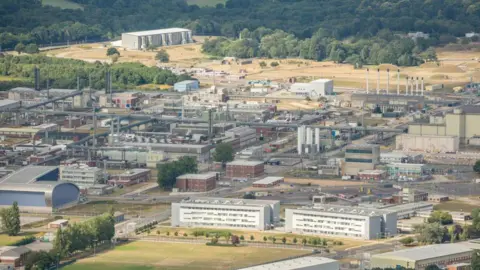What is AWE and why does it need emergency alerts?
 Getty Images
Getty ImagesPeople in the vicinity of two nuclear sites in Berkshire have been urged to sign up to emergency alerts.
The areas around the Atomic Weapons Establishment (AWE) sites in Aldermaston and Burghfield are covered by Detailed Emergency Planning Zones (DPEZs) - a legal requirement around licenced nuclear sites.
As part of this, the organisation has introduced an emergency text alert system, where people can be notified in the event of a nuclear emergency.
What happens at AWE?
AWE is a non-departmental public body, owned by the Ministry of Defence. It is responsible for developing, manufacturing and maintaining the UK's nuclear weapons.
It has two sites in Berkshire - one in Aldermaston and one in Burghfield.
As part of this, high explosives and radioactive substance are used on the sites under controlled conditions.
Ionising radiation
 Getty Images
Getty ImagesWe are exposed to ionising radiation all the time - mostly from natural sources, but also from things like X-ray machines.
Usually, the danger is removed as soon as you are away from the source, and you do not become radioactive as a result.
But, if radioactive material is in a form where it can be easily spread around - like a gas or a very fine powder - then it can get inside the body.
For example through breathing it in or consuming food or drink that has been contaminated by radioactive particles.
When the radiation is absorbed, it can cause changes to the body at a molecular level. These changes can lead to negative health effects such as cancer.
What are the risks at AWE?
AWE said there were no nuclear reactors on site, so there was "no risk" of a Fukushima or Chernobyl-type disaster.
But if there was an uncontrolled fire or an explosion in a building where radioactive materials are behind used, that could lead to radiation particles being released into the environment, which could then lead to people being contaminated.
Because of this risk, AWE and West Berkshire Council (WBC) have rules about what people within the DEPZ should do in the event of a nuclear emergency - and that's where the emergency alerts come in.
 Getty Images
Getty ImagesWhat will the emergency alert say?
According the WBC, the emergency text would inform people there has been an incident at either Aldermaston or Burghfield.
It would tell them to go indoors, close windows and tune into local media if they are in the affected area.
If they are not in the DEPZ at the time, they would not need to follow the instructions in the text.
But it would still useful to get the warning, because people may not be able to return to the affected area until after the alert has passed.
What are the areas covered by the alerts?
The alerts cover the DEPZs surrounding the two sites.
But in the event of a disaster, the radioactive particles could be carried in a plume and the extent of this would depend on the weather conditions at the time.
As a result, while the potential affected area is calculated using estimated wind strength, in the event of an emergency experts would use computer modelling to track and forecast the actual risk, WBC said.
How likely is a nuclear emergency?
Both WBC and AWE said an emergency alert was "unlikely".
But, by law, the local authority has to have a plan about what to do just in case.
You can follow BBC Berkshire on Facebook, X (Twitter), or Instagram.
